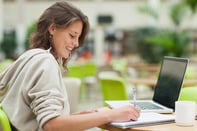Published on
Mobile Technology For Learning And Results

The EvoLLLution interviewed long-time Professor of Educational Technology Allison Rossett about the value and importance of mobile technology to learning. Rossett, currently teaching at San Diego State University, recently published a new edition of her bestselling First Things Fast: A Handbook for Performance Analysis.
What is the value of mobile technology for learning?
Do you want to send your salespeople to training to memorize product features and prices? Would you take a class to prepare to get the very most from your time during a short visit to Paris? Do you want your physician to rely on her memory to anticipate all possible negative drug interactions? I bet you do not.
You can use mobile technology to make sure growth and support happen throughout the year—at the learner’s convenience—rather than in a single, information-packed session.
You may not be able to use mobile devices for learning, so that your students know things by heart, but you might use smart phones and tablets to, for example, provide examples, stretch practices, connections with peers and coaches, and access to suggestions and policies as life and work challenges present themselves.
Are mobile devices popular for learning?
When San Diego State University (SDSU) colleague Jim Marshall and I surveyed more than a thousand educators in companies, agencies and universities about their eLearning practices, they reported reliance on traditional eLearning approaches—like scenarios, virtual classrooms, and online assessments. Performance support and mobile devices only rarely appeared in the organizational playbook they reported. As we look at more recent data, we find an uptick for performance support, in general, but not yet for mobile delivery.
How could that be, I wondered? So I have asked four public audiences about their deployment of mobile devices for enterprise learning and support. The responses were consistent with our survey findings. With hundreds in these rooms, only a few hoisted their hands.
Workplace learning people like mobile methods, but they are not consistently turning to them. Some explanations say the platforms of mobile learning are confusing, with people unable to get past the idea that it’s not about courses on a phone. Others think it comes down to habits. Professors prefer scheduled classes. Students only know the education they have already experienced. Workplace learning metrics favor butts in seats and hits on web site. If you want to take a deep dive into your readiness for mobile strategies, please visit why aren’t mobile learning and support everywhere?
How do we get over the hump?
Learning leaders must see things differently and clearly illustrate the potential for change. I mean if we don’t get it, how can we—through real projects, examples, and measured results—move our organizations and colleagues forward?
First, it’s important to understand the possibilities. Consider the ways that you are using mobile devices in your life. Now look to enterprise problems and opportunities. Where would mobile learning and support boost performance and capacity?
Immerse yourself in the world of mobile learning. Attend conferences, read books and blogs, follow targetted twitterstreams like #mlearncon, #mlearning and #realwplearn. Also, don’t be afraid to talk to consultants and vendors. Approach with a grain of salt, of course, but recognize that consultants and vendors are the ones who have done it more than once.
Once you have a feel for it, why not try something small to add practice or community to a class? Or perhaps you might want to deliver examples or checklists that extend messages into the workplace. Pilot the possibilities. Invite line leaders to download an app that supports better writing, wine choices or travel. Ask them to think about how similar approaches might influence sales people, truck drivers, college instructors, or store managers. Let them whet their whistles with the possibilities.
Finally, the most obvious step: measure and improve your program. Most of what we are attempting with mobile devices is brand spanking new. We need insight into what works and what does not. No mobile program, no matter how exciting, should go unexamined.
Author Perspective: Educator



